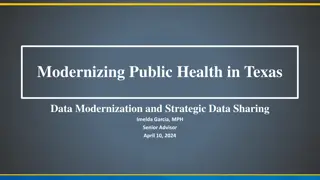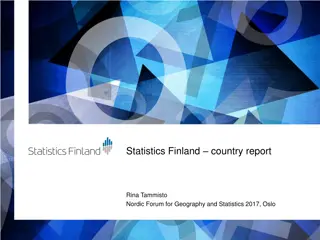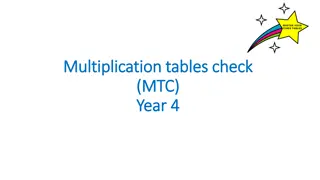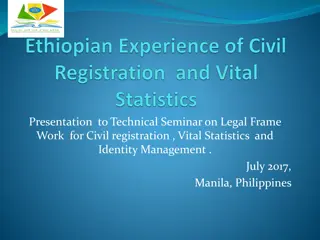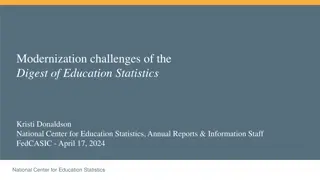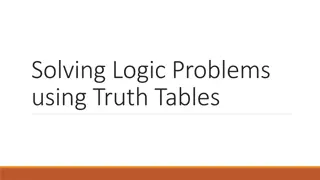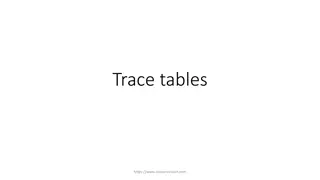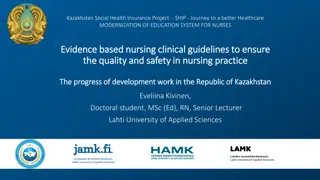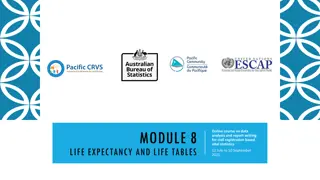Modernizing Statistics Education: From Tables to Software
Sections 6.5 to 6.7 of the course material discuss the transition from using tables for calculations to modern tools like calculators and software such as Excel in statistics education. The focus is on converting to and from standard normal, utilizing Excel functions effectively, and understanding normal probabilities and z-scores. Visual aids and practical examples help solidify understanding and enhance learning outcomes.
Download Presentation

Please find below an Image/Link to download the presentation.
The content on the website is provided AS IS for your information and personal use only. It may not be sold, licensed, or shared on other websites without obtaining consent from the author.If you encounter any issues during the download, it is possible that the publisher has removed the file from their server.
You are allowed to download the files provided on this website for personal or commercial use, subject to the condition that they are used lawfully. All files are the property of their respective owners.
The content on the website is provided AS IS for your information and personal use only. It may not be sold, licensed, or shared on other websites without obtaining consent from the author.
E N D
Presentation Transcript
TABLES AND SOFTWARE Sections 6.5 to 6.7 make antiquated use of tables for calculations. Nowadays we use a calculator or software such as Excel.
SOME REQUIREMENTS FOR SOLUTIONS To do calculations, convert to and from the standard normal. If we use non-standard Excel functions like NORM.DIST, we miss out on the extra grappling with the material that happens with the conversions. Draw pictures for each problem: pedagogically solidifies the topic in our minds; serve as reality check for our numeric solutions.
SECTIONS TO BE COVERED AND THEIR FOCUS 6.5: we convert to Standard & use NORM.S.DIST to find probabilities 6.6: some important properties 6.7: given probabilities, we use NORM.S.INV to find z-scores then De standardize to find scores.
6.5 FINDING NORMAL PROBABILITIES (VIA STANDARD NORMAL AND NORM.S.DIST) Given a normal random variable, we standardize by subtracting the mean and dividing by the standard deviation x z = The effect is to convert a score x to a z-score z.
CONVERTING A SCORE TO A ZSCORE Example: The mean for the heights of male students in a school is 5 10 =70 and the std dev is 2.5 . What is the zscore for a male student who is 6 2 =74 tall? ? =74 70 2.5=8 4 = 5= 1.6 2.5 We interpret this as: The student s height is 1.6 standard deviations (in the positive direction) from the mean.
x TRANSFORMING TO STANDARD NORMAL = z Suppose that the mean for the heights of male students in a school is 5 10 =70 and the std dev is 2.5 . What portion of the male students are less than 6 2 =74 tall? Nonstandard inequality is X<74. If we standardize both sides, we get ? 70 < 74 70 ? 70 < 4 ? 70 2.5 2.5 Z <8 5= 1.6 In terms of probabilities, this means P(X < 74) = P(Z < 1.6) We use Excel s standard normal distribution to get the answer: = NORM.S.DIST(1.6, TRUE) = 94.5% We conclude with a sentence: 94.5% of the male students in the school are less than 6 2 tall. 4 <
GRAPH FOR HEIGHT PROBLEM (NO PICTURE, NO CREDIT): P(X<74) = P(Z<1.6) = 94.5% 70 72.5 75
EXAM SCORE EXAMPLE Scores for an entrance exam are normally distributed with =70 and =10. What is the chance that a random applicant scores below 90? Above 85? 90 is 2 standard deviations above mean. Remembering that there is 2.5% in each tail, then the chance of being below 90 is 1 2.5% = 97.5%. For the other question, the algebra, excel command and picture are below: 85 15 15 10 1.5 X 70 70 X X P(X > 85) = P(Z > 1.5) = 6.7% 10 Z =1-NORM.S.DIST(1.5,TRUE)
EXERCISE 6.5.2 If X is normal with mean 10 and standard deviation 3, find (a) P{X > 12} (c) P{8 < X < 11} (e) P{|X 10| > 5}
EXERCISE 6.5.6 AND 6.5.7: TIRE LIFETIME 6. The life of a certain automobile tire is normally distributed with mean 35,000 (=35k) miles and standard deviation 5000 (=5k) miles. a) What proportion of tires last between 30,000 (30k) and 40,000 (40k) miles? (i.e., P{|Z | < 1}) b) What proportion of such tires last over 40,000 miles (40k)? (P{Z >1}) c) What proportion last over 50,000 miles (=50k)?(P{Z >3}) 7. If the tire is in working condition after 40,000 miles (=40k), what is the conditional probability that it will still be working after an additional 10,000 miles (=10k)? (i.e., P{Z >3}/ P{Z >1})
6.6 PROPERTIES OF NORMAL RANDOM VARIABLES Recall: for random vars X and Y, E[X + Y] = E[X] + E[Y] = x+ y for INDEPENDENT random vars X and Y: Var(X + Y) = Var(X) + Var(Y) = These results carry over to normal random variables X and Y. In addition, if X and Y are independent, then X+Y will be normal. + 2 x 2 y
EXAMPLES NOT INDEPENDENT Examples of pairs of normal random variables that are not independent: income of households with 2 working adults of different genders. combined height of 2 adults in a household: one female, one male. Can you provide reasons why the above example pairs are not independent? While the expectation will be the sum of individual expectations, the variance will be greater than the sum of the individual variances.
6.7 PERCENTILES OF NORMAL RANDOM VARIABLES (THE INVERSE PROBLEM) The z-score z is the value for which P{Z > z } = : Think of a z-score as a function which inputs a probability 0< <1 and outputs a real number.
EXERCISES 6.7.1-2 6.7.1. Find to two decimal places: (a) z0.07 =NORM.S.INV(1 0.07) (e) z0.65=NORM.S.INV(1 0.65) (f) z0.50 (g) z0.95 6.7.2. Find the value of r for which (a) P{|Z| > r} = 0.05 r=NORM.S.INV(1 0.025)
STANDARDIZING AND DESTANDARDIZING x z x = = Recall that + z If we solve for x we get *Also note that ? =? ? ? Once a z-score is found, we use the above formula to de standardize.
Z-SCORE & SCORE ARE CLOSELY RELATED TO PERCENTILE. If on a test with ? = 20, 75% of the scores were below 30, then 30 is the 75th percentile & 30 is the score x for = 1 .75 =.25. The zscore is NORM.S.INV(0.75)=0.67~2/3. If the mean is 20, then from formula * on previous slide: ? =? ? ?? 2/3 ~30 20 10 2/3= 15 = Area = 75% Area = .25 30 is 75th percentile 30 = x.25
6.7.3. IF X IS A NORMAL RANDOM VARIABLE WITH MEAN =50 AND STD=6, FIND THE APPROXIMATE VALUE OF XFOR WHICH (d) P{X < x} = 0.05 (e) P{X < x } = 0.88 (a) P{X > x } = 0.5 (b) P{X > x } = 0.10 (c) P{X > x } = 0.025 (f) P{|X 50| > x } = 0.05 =6* NORM.S.INV(1 - 0.025) (g) P{|X 50| < x } = 0.65 =6* NORM.S.INV(0.65+0.35/2) x =6* NORM.S.INV(0.05)+50 x =6* NORM.S.INV(1 0.1)+50
6.7.6. The time for junior high girls to run one mile is normally distributed with 460 s and 40 s. - As a selection mechanism, the track team only takes from the top 20%. [ top here means lower times (the lower the time, the faster is the girl).] - What is the critical time below which a girl must reach to make the team? P{X < x} = 0.2 x =40* NORM.S.INV(0.2)+460=426 s or 7 min 6 sec.
6.7.9. The amount of radiation that can be absorbed by an individual before death ensues varies from individual to individual. However, over the entire population this amount is normally distributed with mean 500 roentgens and standard deviation 150 roentgens. Above what dosage level will only 5 percent of those exposed survive? Answer: 747 = 150*NORM.S.INV(1-0.05)+500 These statistics were determined from data collected at the Chernobyl accident. The roentgen is also known as rem. Since then, the unit used for radiation absorption has been changed to the sievert (1sievert = 100 rems). See NY Times graph on next page that was part of discussion of exposure for Fukushima workers.


